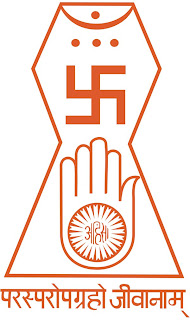Atom Invention and Jainism
The name atom comes from the Greek "ἄτομος"—átomos (from α-, "un-" + τέμνω -temno, "to cut"[2]), which means uncuttable, or indivisible, something that cannot be divided further.[3] The concept of an atom as an indivisible component of matter was first proposed by early Indian and Greek philosophers.
The nature of atoms in philosophy varied considerably over time and between cultures and schools, and often had spiritual elements. Nevertheless, the basic idea of the atom was adopted by scientists thousands of years later because it elegantly explained new discoveries in the field of chemistry.[7]
The earliest references to the concept of atoms date back to ancient India in the 6th century BCE,[8] appearing first in Jainism.[9] The Nyayaand Vaisheshika schools developed elaborate theories of how atoms combined into more complex objects.[10]
9^ Iannone (2001:62).
Jaina school
The most elaborate and well-preserved Indian theory of atomism comes from the philosophy of the Jaina school, dating back to at least the 6th century BC. Some of the Jain texts that refer to matter and atoms are Pancastikayasara, Kalpasutra, Tattvarthasutra and Pannavana Suttam. The Jains envisioned the world as consisting wholly of atoms, except for souls. Paramāņus or atoms were considered as the basic building blocks of all matter. Their concept of atoms was very similar to classical atomism, differing primarily in the specific properties of atoms. Each atom, according to Jain philosophy, has one kind of taste, one smell, one color, and two kinds of touch, though it is unclear what was meant by "kind of touch". Atoms can exist in one of two states: subtle, in which case they can fit in infinitesimally small spaces, and gross, in which case they have extension and occupy a finite space. Certain characteristics of Paramāņu correspond with that sub-atomic particles. For example Paramāņu is characterized by continuous motion either in a straight line or in case of attractions from other Paramāņus, it follows a curved path. This corresponds with the description of orbit of electrons across the Nucleus. Ultimate particles are also described as particles with positive (Snigdha i.e. smooth charge) and negative (Rūksa – rough) charges that provide them the binding force. Although atoms are made of the same basic substance, they can combine based on their eternal properties to produce any of six "aggregates", which seem to correspond with the Greek concept of "elements": earth, water, shadow, sense objects, karmic matter, and unfit matter. To the Jains, karma was real, but was a naturalistic, mechanistic phenomenon caused by buildups of subtle karmic matter within the soul. They also had detailed theories of how atoms could combine, react, vibrate, move, and perform other actions, all of which were thoroughly deterministic.
Source: Wikipedia http://en.wikipedia.org/wiki/Atom
Must Read for More Details: http://www.theosophy-nw.org/theosnw/world/asia/rel-kav3.htm



Comments
Post a Comment